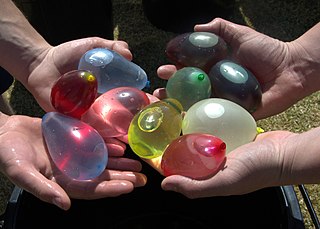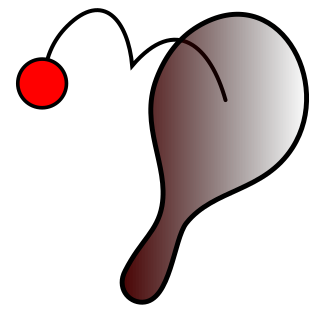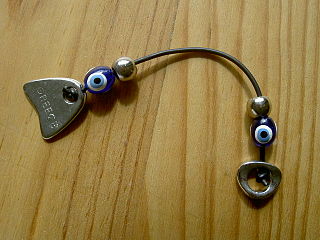
A yo-yo is a toy consisting of an axle connected to two disks, and a string looped around the axle, similar to a spool. It is an ancient toy with proof of existence since 440 BC. The yo-yo was also called a bandalore in the 17th century.

A water balloon or water bomb is a balloon, often made of latex rubber, filled with water. Water balloons are used in a summer pastime of cooling off through water balloon fights. Water balloons are also popular for celebrations, including celebrating Holi and Carnival in India, Nepal, and several other countries.

The diabolo is a juggling or circus prop consisting of an axle and two cups or discs derived from the Chinese yo-yo. This object is spun using a string attached to two hand sticks. A large variety of tricks is possible with the diabolo, including tosses, and various types of interaction with the sticks, string, and various parts of the user's body. Multiple diabolos can be spun on a single string.

A monkey wrench is a type of smooth-jawed adjustable wrench, a 19th century American refinement of 18th-century English coach wrenches. It was widely used in the 19th and early 20th century. It is of interest as an antique among tool collectors and is still occasionally used in practice.

The kendama is a traditional Japanese skill toy. It consists of a handle (ken), a pair of cups (sarado), and a ball (tama) that are all connected together by a string. On one end of the ken is a cup, while the other end of ken is narrowed down, forming a spike (kensaki) that fits into the hole (ana) of the tama. The kendama is the Japanese version of the classic cup-and-ball game, and is also a variant of the French cup-and-ball game bilboquet. Kendama can be held in different grips, and many tricks and combinations can be performed. The game is played by tossing the ball into the air and attempting to catch it on the stick point.

Astrojax, invented in 1986 by Larry Shaw, is a toy consisting of three balls on a string. In the original version of the toy, one ball is fixed at each end of the string, and the center ball is free to slide along the string between the two end balls. Inside each ball is a metal weight. The metal weight lowers the moment of inertia of the center ball so it can rotate rapidly in response to torques applied by the string. This prevents the string from snagging or tangling around the center ball.

Bop It toys are a line of audio games. By following a series of commands issued through voice recordings produced by a speaker by the toy, which has multiple inputs including pressable buttons, pull handles, twisting cranks, spinnable wheels, flickable switches, the player progresses and the pace of the game increases.
Steve Brown is an American competitive yo-yo player, competition judge, yo-yo designer, and yoyo blogger currently based out of North Olmsted, Ohio. He is currently the editor for YoYoNews.com and a co-producer of the Triple Crown of YoYo events. In 2001, the National Yo-Yo League named him as one of eight National Yo-Yo masters. He has designed multiple yo-yos, including the "Cherry Bomb" for Team Losi. While employed by Duncan Toys Company as marketing and promotions coordinator, Brown invented and patented freehand yo-yo play where instead of being attached to the finger, the string is actually attached to a counterweight, and designed a line of yo-yos for the new style. He also authored a book called Duncan Yo-Yo Trick Book while employed by the company.

Slip ’N Slide is a children's toy invented by Robert Carrier and manufactured by Wham-O. It was first sold in 1961. The main form is a plastic sheet and a method of wetting it; when the surface is wet it becomes very slippery, thus allowing the user to slide along it. Some versions also include an inflatable swimming pool for the user to slide into at the end of slide, and spray tubes.

Paddle ball is a one-person game played with a paddle and an attached ball. Using the flat paddle with the small rubber ball attached at the center via an elastic string, the player tries to hit the ball with the paddle in succession as many times as possible.

Educational toys are objects of play, generally designed for children, which are expected to stimulate learning. They are often intended to meet an educational purpose such as helping a child develop a particular skill or teaching a child about a particular subject. They often simplify, miniaturize, or even model activities and objects used by adults.
Object manipulation is a form of dexterity play or performance in which one or more people physically interact with one or more objects. Many object manipulation skills are recognised circus skills. Other object manipulation skills are linked to sport, magic, and everyday objects or practices. Many object manipulation skills use special props made for that purpose: examples include the varied circus props such as balls, clubs, hoops, rings, poi, staff, and devil sticks; magic props such as cards and coins; sports equipment such as nunchaku and footballs. Many other objects can also be used for manipulation skills. Object manipulation with ordinary items may be considered to be object manipulation when the object is used in an unusually stylised or skilful way or for a physical interaction outside of its socially acknowledged context or differently from its original purpose.

Yo-kai Watch is a Japanese media franchise created and developed by Level-5. The franchise's main work is the role-playing video game series of the same name, the first of which was released for the Nintendo 3DS in 2013. Three main sequels and several spinoffs, on both Nintendo and mobile platforms, have been released. In December 2019, the franchise expanded to PlayStation with the release of Yo-kai Watch 4++. An associated toy line is produced by Bandai for the Japanese market, while Hasbro formerly sold the toys under license in the Americas and Europe.

A pullstring, pullcord, or pullchain is a string, cord, or chain wound on a spring-loaded spindle that engages a mechanism when it is pulled. It is most commonly used in toys and motorized equipment. More generally and commonly, a pullstring can be any type of string, cord, rope, or chain, attached to an object in some way used to pull or mechanically manipulate part of it.

An Eskimo yo-yo or Alaska yo-yo is a traditional two-balled skill toy played and performed by the Eskimo-speaking Alaska Natives, such as Inupiat, Siberian Yupik, and Yup'ik. It resembles fur-covered bolas and yo-yo. It is regarded as one of the most simple, yet most complex, cultural artifacts/toys in the world. The Eskimo yo-yo involves simultaneously swinging two sealskin balls suspended on caribou sinew strings in opposite directions with one hand. It is popular with Alaskans and tourists alike. This traditional toy is two unequal lengths of twine, joined together, with hand-made leather objects at the ends of the twine.

Yo-kai Watch 2: Bony Spirits and Yo-kai Watch 2: Fleshy Souls are a pair of 2014 role-playing video games developed and published by Level-5 for the Nintendo 3DS. The games are a sequel to 2013's Yo-kai Watch, and were released in July 2014 in Japan, in North America and Australia in late 2016, and Europe in 2017. Much like their predecessor, the games put players in an open world, befriending and battling various Yo-kai, which are ghosts and apparitions originating in Japanese folklore, that cause mischief in daily life. In the beginning of the story, the memories of the protagonists Nathan "Nate" Adams and Katie Forester are erased when their Yo-kai Watch is stolen, leaving them with no recollection of their past adventures. However, they soon stumble across their Yo-kai butler Whisper once again, and their adventures resume.

String is a long flexible structure made from fibers twisted together into a single strand, or from multiple such strands which are in turn twisted together. String is used to tie, bind, or hang other objects. It is also used as a material to make things, such as textiles, and in arts and crafts. String is a simple tool, and its use by humans is known to have been developed tens of thousands of years ago. In Mesoamerica, for example, string was invented some 20,000 to 30,000 years ago, and was made by twisting plant fibers together. String may also be a component in other tools, and in devices as diverse as weapons, musical instruments, and toys.

Begleri is a small skill toy consisting of one or more beads at either end of a short string or chain. It can be flipped and twirled around the fingers to perform tricks. The begleri originated in Greece, and was originally derived from the komboloi, which serves the function of worry beads, and are often flipped around to pass the time or keep the hands busy. While komboloia have beads forming a closed circle, begleri beads are threaded on an open strand, usually in a symmetrical formation, with equal weighting at either end; this is sometimes referred to as "open-string begleri". Begleria come in many forms, consisting of semi-precious stone or metal beads. They can be similar in form to the percussion instrument kashaka, but are much smaller in size.















